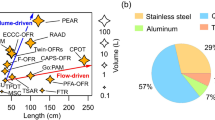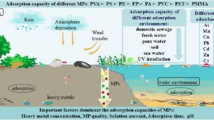Abstract
Until now, quantitative contributions of hydrophilic and hydrophobic water-soluble organic carbon (WSOC) fractions to aerosol light extinction have not been studied. In this study, concentrations of chemical species in PM2.5 (particulate matter with diameters less than 2.5 µm), including elemental carbon (EC), organic carbon (OC), total WSOC, two fractionated WSOCs, water-soluble inorganic species, and metal species, were measured twice a day between December 27, 2010 and January 20, 2011, at an urban site in Seoul, Korea. A macro-porous XAD7HP resin column was used to separate the liquid extracts into hydrophilic and hydrophobic WSOC (WSOC HPI and WSOC HPO ) fractions. Water-insoluble OC (WIOC), WSOC HPI and WSOC HPO were used to estimate the aerosol light extinction from the original IMPROVE algorithm. Organic mass to organic carbon (OM/OC) ratios of 1.6, 2.0, and 1.8 were applied to the WIOC, WSOC HPI , and WSOC HPO , respectively. Light extinctions for ammonium sulfate, ammonium nitrate, POM (particulate organic matter = WIOM + WSOM HPI + WSOM HPO ), and EC (which is light absorbing) were determined as 38.9 ± 34.0, 64.7 ± 70.6, 69.5 ± 27.7, and 27.1 ± 11.0 Mm−1, respectively, and contributed 15.0% (range: 5.4–25.6), 22.2% (7.1–50.8), 30.8% (13.0–42.3) and 12.0% (5.1–21.3), respectively, to the total light extinction budgets. Light scattering due to the WIOM, WSOM HPI and WSOM HPO were 27.3 ± 13.1, 17.1 ± 8.7, and 24.1 ± 9.9 Mm−1, respectively, and accounted for 12.5, 7.5, and 10.7% of the total light extinction budget. The results indicate WSOC HPO has a greater impact on visibility reduction in wintertime than WSOC HPI at this site. Light scattering by total OC concentration (POM=1.6 × OC) was 62.2 ± 25.1 Mm−1, which was approximately 9.7% lower than the sum of light scattering due to each of the three OC components with different OM/OC ratios. As the relative humidity (RH) increased, light extinction was higher in the water-soluble inorganic components ((NH4)2SO4 and NH4NO3) than in the water-soluble organic fractions. In the IMPROVE algorithm, the hygroscopic growth factor for POM was assumed to be 1 (non-hygroscopic) due to a lack of evidence for water growth by ambient POM. However, the relationships between the RH and light scattering due to WSOM HPI (R2=0.49) and WSOM HPO (R2 = 0.31) suggest that different hygroscopic growth factors should be applied to the hydrophilic and the hydrophobic WSOC fractions. Consequently, additional experimental work is needed to explore hygroscopic growth curves for the two fractionated WSOC components.
Similar content being viewed by others
References
W. C. Malm and J. L. Hand, Atmos. Environ. 41, 3404 (2007).
K. W. Kim, J. Korean Phys. Soc. 59, 189 (2011).
K. W. Kim, S. S. Park, K. H. Lee and Y. J. Kim, J. Korean Phys. Soc. 62, 186 (2013).
U. S. Environmental Protection Agency (US EPA), Air quality strategies and standards division visibility and ecosystems protection group, Visibility Monitoring Guidance Document.
B. J. Turpin and H. J. Lim, Aerosol Sci. Technol. 35, 602 (2001).
J. L. Hand and W. C. Malm, Review of the IMPROVE equation for estimating ambient light extinction coefficients (http://vista.cira.colostate.edu/improve/Publications) (2005).
B. R. T. Simoneit, M. Kobayashi, M. Mochida, K. Kawamura, M. Lee, H. J. Lim, B. J. Turpin and Y. Komazaki, J. Geophys. Res. 109, D19S10 (2004).
S. S. Park and S. Y. Cho, Atmos. Environ. 45, 60 (2011).
S. Ruellan and H. Cachier, Atmos. Environ. 35, 453 (2001).
S. S. Park, S. Y. Cho, K.W. Kim, K. H. Lee and K. Chung, Atmos. Environ. 55, 64 (2012).
M. Kanakidou et al., Atmos. Chem. Phys. 5, 1053 (2005).
P. Saxena and L. M. Hildemann, J. Atmos. Chem. 24, 57 (1996).
R. J. Weber et al., J. Geophys. Res. 112, D13302 (2007).
P. Saxena, L. M. Hildemann, P. H. McMurry and J. H. Seinfeld, J. Geophys. Res. 100, 18755 (1995).
Z. Krivácsy et al., J. Atmos. Chem. 39, 235 (2001).
S. Decesari, M. C. Facchini, E. Matta, S. Fuzzi and E. Tagliavini, J. Geophys. Res. 105, 1481 (2000).
A. P. Sullivan and R. J. Weber, J. Geophys. Res. 111, D05314 (2006).
S. S. Park, J. H. Jeong and S. Y. Cho, Asian J. Atmos. Environ. 6, 67 (2012).
S. S. Park, J. H. Kim and J. U. Jeong, J. Environ. Monit. 14, 224 (2012).
K. W. Kim, Y. J. Kim and S. J. Oh, Atmos. Environ. 35, 5157 (2001).
K. W. Kim, Z. He and Y. J. Kim, J. Geophys. Res. 109, D19S02 (2004).
K. W. Kim, Atmos. Environ. 41, 3565 (2007).
L. Yang, X. Zhou, Z. Wang, Y. Zhou, S. Cheng, P. Xu, X. Gao, W. Nie, X. Wang and W. Wang, Atmos. Environ. 55, 506 (2012).
National Institute of Occupational Safety and Health (NIOSH), Method 5040 Issue 1: Elemental Carbon (Diesel Exhaust) (Cincinnati, OH, 1996).
W. C. Malm, J. F. Sisler, D. Huffman, R. A. Eldred and T. A. Cahill, J. Geophys. Res. 99, 1347 (1994).
M. Pitchford, W. Malm, B. Schichtel, N. Kumar, D. Lowenthal and J. Hand, J. Air & Waste Manage. Assoc. 57, 1326 (2007).
K. W. Kim, Korean J. Chem. Eng. 30, 1436 (2013).
M. Pitchford and M. Green, J. Air & Waste Manage. Assoc. 47, 136 (1997).
N. Lagrosas, H. Kuze, N. Takeuchi, S. Fukagawa, G. Bagtasa, Y. Yoshii, S. Naito and M. Yabuki, J. Aerosol Sci. 36, 439 (2005).
Author information
Authors and Affiliations
Corresponding author
Rights and permissions
About this article
Cite this article
Park, S.S., Kim, K.W. & Schauer, J.J. Influence of hydrophilic and hydrophobic water-soluble organic carbon fractions on light extinction at an urban site. Journal of the Korean Physical Society 63, 2047–2053 (2013). https://doi.org/10.3938/jkps.63.2047
Received:
Accepted:
Published:
Issue Date:
DOI: https://doi.org/10.3938/jkps.63.2047




